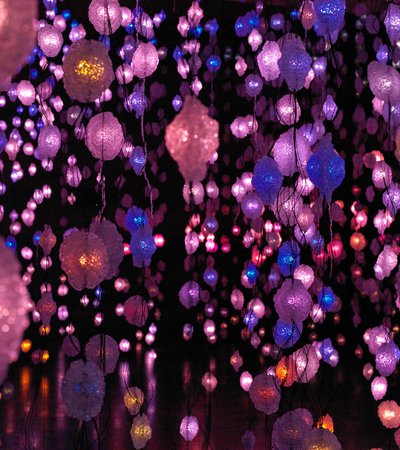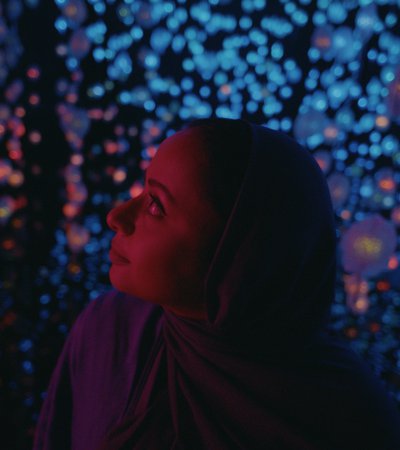In choosing the music for the exhibition, Rist was looking for a sonic choreography that would cover a wide range of moods and emotions. The result is a range of rather touching but also more ambient sounds, leaving some space for the individual visitor’s emotions to unfold. She also wanted to allude to the contrariness of human emotions. Thus the music is both melancholic and uplifting. Here, the artist shares her lifelong connection to music and how she selected the works for Your Brain to Me, My Brain to You.
Music is a central pillar of Your Brain to Me, My Brain to You, underlining the flow of the lights and creating an inviting and all-embracing atmosphere. A journey of both sight and sound, the exhibition highlights the important role that music has played in Pipilotti Rist’s career.
Pipilotti Rist: Music has always helped me to feel lighter and lifted from the wants and worries of everyday life. I use music myself to transcend to other levels of consciousness and celebrate life and feelings. Music seems often like a collective thinking bubble where our heartbeats melt together.
Beginning in my teenage years I listened to music and went to concerts. One of my oldest friendships with graphic designer Thomas Rhyner originated in a shared love of music and I always joked that as my life partner I would choose the one person with the nicest music selection - and so I did!
My love of music brought me to design the stages for bands long before I considered myself an artist. My first Super 8 films and slide projections were designed for the stage, to illuminate the musicians. I wanted to be in service of the music. In a way, I am still creating music stages – except instead of a band, there are visitors now.
And while I loved to make music myself, I suffered a bad case of stage fright. One of the bands I worked with asked me to come onto the stage anyways, so I became a bassist, flute player and drummer as well as singer for the band Les Reines Prochaines (The Queens of the Future). Unfortunately, my stage fright didn't get better with practice, and I decided to concentrate on recorded music and video installations, but I had learnt how to mix 8-channel music at least. Music has continued to be half of the quality and effect of our room installations.
“ In a way, I am still creating music stages – except instead of a band, there are visitors now. ”Pipilotti Rist
When choosing the music for my installations, in the past I visited concerts and was in conversation with many of my music-loving or even music-producing friends, trying out and collaborating with many like Anders Guggisberg or Roland Widmer. They would recommend other people or techniques to me, and thus I was always involved with music, including singing and producing myself.
My research has largely shifted to Spotify or other online platforms. I listen restlessly and until deep into the night, creating many playlists and being in direct conversation with the musicians I like. There is nearly always music playing at my house. This is how I found the musicians Surma or Clarissa Bitar, for example.
I am also aware of talent in my closer surroundings. So when I heard the young musician and piano player Seraphin Basedau practice his tunes, I had the idea to describe to him my ideas for this video installation. With my vision in mind, Seraphin improvised on the piano, we recorded it and with the help of the sound designer Roland Widmer, the instrumental song was born.
“ It's not about forgetting our problems, it's about bringing them into a different focus so that they don't burn into the brain. ”Pipilotti Rist
I always liked to learn more about the cultural backgrounds of the countries I exhibit in and for the installation in Doha the specific sound of the oud struck me as an Arab wonder. I was captivated by it right away. When I looked for oud players, I came across Clarissa Bitar, a musician from Los Angeles with Palestinian roots. So while I indeed wanted to incorporate local music into my piece, my artistic vision and appreciation of the music were the main reason. It is not something I usually do but I remain open to it when I come across music and sounds that fascinate me.
I want our installations to feel like a safe space where people can relax. Focusing on something allows the brain to regenerate, and offering that regeneration is a strength of art. It's not about forgetting our problems, it's about bringing them into a different focus so that they don't burn into the brain. I want the visitors to envision other people's minds and dig deeper in their own aesthetic experience.
The artist wishes to thank Nike Dreyer for her collaboration on this article.
Your Brain to Me, My Brain to You is on view at the National Museum of Qatar until 30 April 2024.

Pipilotti Rist: Your Brain to Me, My Brain to You

Light, Colour and Imagination: Pipilotti Rist at Qatar Museums